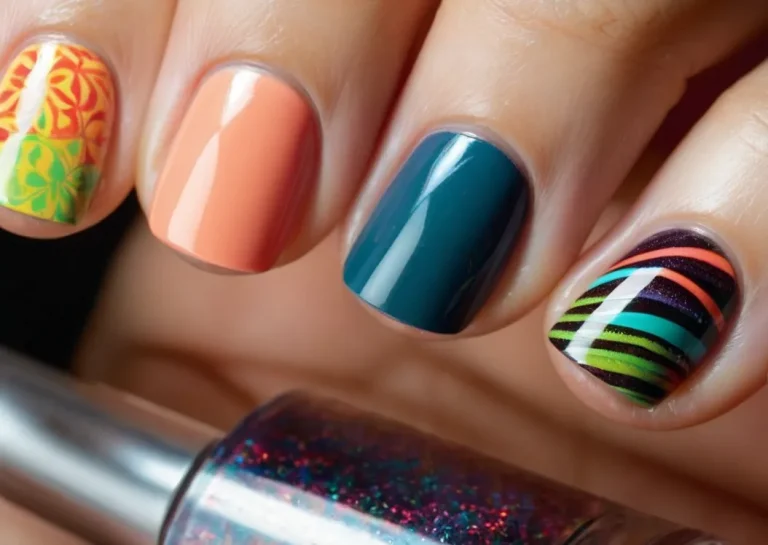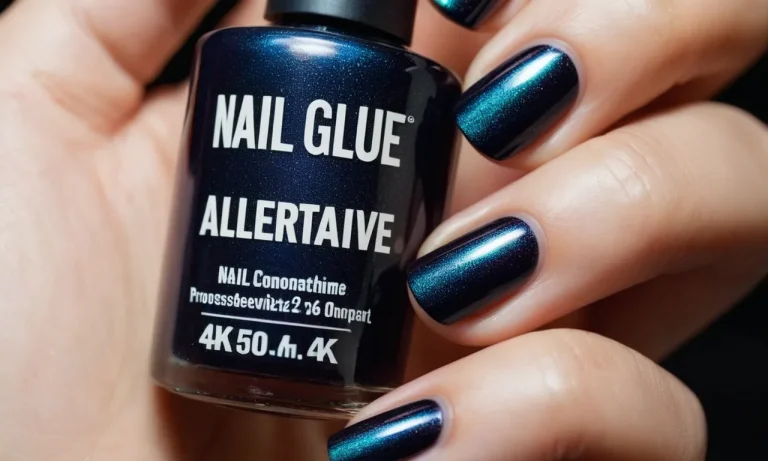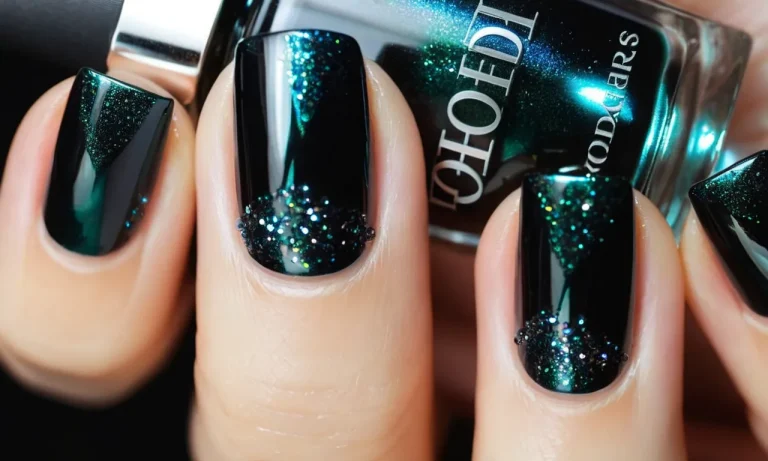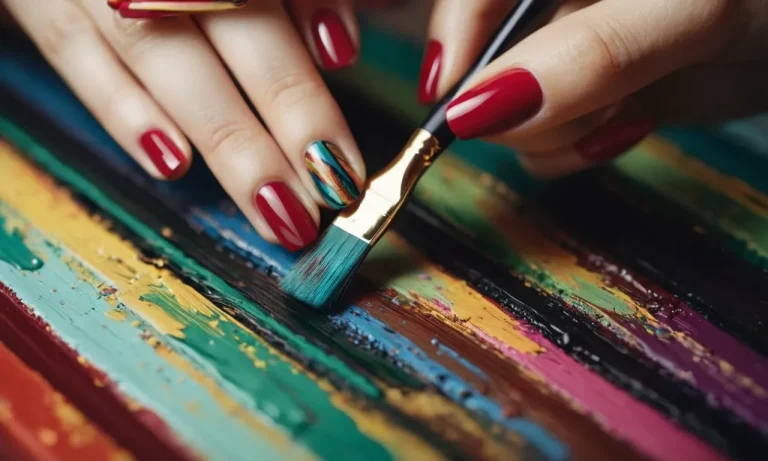Can’T Do Gel Nails? 9 Safer Alternatives For People With Allergies
Gel manicures are known for their long-lasting shine and chip-resistant wear. But for some, the chemicals in gel polish can cause pesky allergic reactions. If you find yourself with irritated, peeling, or cracked nails after a gel mani, it’s likely time to explore safer options. The good news?
You’ve got choices. From natural nail polishes to press-on nails, here are 9 gel nail alternatives ideal for sensitive nails.
Understand What You’re Allergic To
The Main Culprits: Methacrylates
Methacrylates are the primary allergens found in gel manicure systems that can cause contact dermatitis in some people. Methacrylates are a family of chemicals used to make the strong, flexible polymers that give gel manicures their durability and shine. The main methacrylate ingredients are:
- Methyl methacrylate (MMA)
- Ethyl methacrylate (EMA)
- Hydroxypropyl methacrylate (HPMA)
- Hydroxyethyl methacrylate (HEMA)
- Ethylene glycol dimethacrylate (EGDMA)
Unfortunately, exposure to methacrylates can cause allergic reactions in a small percentage of the population. Common symptoms include redness, swelling, itching, and blistering around the nail and cuticle areas. In severe cases, the reaction can spread across the fingers and even up the hands.
Methacrylate allergy usually develops over time with repeated exposure rather than occurring immediately.
The good news is that not all gel manicure products contain high levels of methacrylates. Manufacturers have reformulated many gel polish lines to reduce the concentration of sensitizing ingredients. However, it’s still important to be aware of the risks and monitor yourself closely for any negative reactions.
Patch Testing Can Help Identify Specific Allergens
If you suspect you have a methacrylate allergy, it’s advisable to get patch testing done. This simple procedure identifies exactly which chemicals your skin reacts to. A dermatologist places small samples of common allergens on your back and monitors for reactions over 48 hours.
This helps pinpoint the specific methacrylates or other ingredients causing problems for you personally.
Armed with patch test results, you can then more safely explore gel alternatives that don’t contain your allergenic triggers. You may be fine with some types of gels but not others. For example, a person allergic to HEMA could potentially tolerate an EMA-based gel formula.
Working with your dermatologist helps take the guesswork out of navigating gel manicure options.
Try Natural Nail Polish
Water-Based Polishes are Hypoallergenic
For people with nail polish allergies or sensitivities, water-based polishes are a great hypoallergenic option. These polishes are free of many harsh chemicals like formaldehyde, toluene, dibutyl phthalate (DBP), and camphor that are commonly found in regular polishes.
Instead, water-based formulas use ingredients like water, glycerin, and acrylates copolymer to create a smooth, chip-resistant manicure without the risk of irritation.
Many popular natural nail polish brands like Ella+Mila, RGB, and Zoya use this water-based formula. These polishes go on smooth, dry quickly, and last 5-7 days on most people. The range of trendy colors and finishes is impressive too – from nudes and pinks to emeralds and navy blues in cremes, shimmers, and metallics.
Those with sensitivities can comfortably wear these polishes without red, itchy, or inflamed nails afterwards.
Mineral-Based Formulas are Non-Toxic
Another hypoallergenic nail polish option is formulas made with mineral pigments and natural ingredients. Brands like Sundays Non-Toxic Polish and Bio Seaweed Gel use mineral colors and clays along with nourishing oils, aloe vera, and seaweed extracts to create polishes free of the “toxic trio.”
These toxin-free polishes help avoid nasty nail reactions while making nails look naturally beautiful.
The earth-derived mineral pigments also allow for rich, vibrant shades of color. Expect to find every hue from glossy reds to pastel pinks and sunny yellows. Many mineral polishes like those from Piggy Paint and Honeybee Gardens are also certified cruelty-free and vegan.
Those with environmental concerns appreciate these ethically-made polishes too.
Swap Gel for Dip Powder Nails
If gel nails are causing skin irritation or allergic reactions, swapping to dip powder nails can be a safer alternative. Dip powder nails provide a durable, long-lasting manicure without using harsh UV lamps or acrylic. Here’s what you need to know about trying dip nails instead.
What Are Dip Powder Nails?
Dip powder nails consist of a powder formulation that hardens when activated by a liquid bonding agent. After pushing the nails into acolored powder, a special liquid is brushed over the nail to instantly dry and set the powder in place.
Multiple thin layers create a sturdy, chip-resistant nail that can last 2-3 weeks with no nicks or cracks.
The ingredients are finely milled powder particles along with glue resin rather than harsh acrylics or gels. This allows the natural nail to grow out cleanly without heavy damage when removed. Dip powders skip UV lamps and limit exposure to fumes, making them gentler on sensitive skin.
Benefits of Dip Nails
Compared to UV gel polish, dip powder nails offer quite a few advantages:
- No UV light curing, reducing skin exposure
- Less odor and fumes released
- Gentler removal process for natural nails
- Long lasting 2-3 week wear
- Over 35 fun colors and finishes to choose from
The durability of dip powder color exceeds regular polish by wide margins. The layers form a hardened shield of protection that resists chips and scratches for 14-21 days of perfect nails.
Applying Dip Powder Nails
The application process is straightforward with just a few steps:
- File and prep nails
- Push nails into colored dip powder to coat
- Brush special liquid activator over powder
- Repeat dipping and activing for 2-3 layers
- Shape and buff nails
- Apply top coat to seal and add shine
With no need to sit under a UV or LED lamp for hardening, the process moves faster. Dipping into powders and brushing on the adhesive takes only a few minutes per layer. The finished manicure lasts just as long with fewer risks.
Removing Dip Powder Nails
Taking off dip powder nails is easier on natural nails too. Rather than harsh acetone and foil wraps, dip manicures can be removed by:
- Filing off the top layer
- Soaking in acetone for 10-15 minutes
- Gently pushing off the powder with an orangewood stick
There are also special dip powder nail remover kits with less acetone to dissolve layers while minimizing damage. This keeps natural nails in better shape than gel formula removals after 2-3 weeks of wear.
For those with acrylic or gel allergies, swapping to a dip powder manicure can allow enjoying long-lasting polish with fewer risks. The durable colors avoid chips and cracks for 2-3 weeks with gentler application and removal methods. Dip powder nails offer a safer, hardy alternative to gel manicures.
Explore UV/LED-Free Gel Alternatives
Try Builder Gels
Builder gels provide a safer alternative for those with gel or acrylic nail allergies. These gels gently extend natural nails using safe, flexible materials. Builder gels form strong, durable enhancements without harsh chemicals or UV lamps.
Popular options like Gelish Builder in a Bottle, OPI Builder in a Bottle, and Cuccio Pro Powder provide salon-quality results at home.
These builder gel systems apply like polish with a brush. They cure under an LED light within minutes for convenience compared to typical gels. Structurally, builder gels differ using safer monomer formulations sans common allergens like HEMA, TEGDMA, or MMA.
For instance, Gelish Builder relies on hydroxyethyl methacrylate (HEMA)-free, non-toxic polyurethane resins to extend nails. This flexible, breathable material feels light as your own nails. Likewise, OPI Builder avoids HEMA, toluenes, DBP, and formaldehyde for safer sculpting.
The brand also offers 38 versatile, skin-friendly colors like pale rose blonde to deep red. For chemical-sensitive clients, Cuccio Powder uses HEMA-free liquids to fuse layers of colored powder dust for a hypoallergenic acrylic alternative.
Give Bio Sculpture Gel a Go
The original bio-friendly sculpture gel, Bio Sculpture Gel (BSG) was created by a cosmetic chemist to pioneer safer, flexible gel polish. Ninety-five percent organic, this non-toxic formula avoids harsh acrylates and plasticizers that often irritate nails.
Instead of HEMA, TEGDMA or MMA, BSG relies on naturally-derived humectants like green tea extract and silicones to condition nails. The brand’s Bio Gel colors offer 165+ vibrant shades to suit any taste, from nudes and pinks to reds and vampy darks.
The original BSG system applies sculpting layers over nail tips for extensions or overlays on natural nails. Compared to rigid acrylic or gel sets, BSG remains flexible to prevent cracks and breaks. Nails gain strength over time as the material bonds safely to allow comfortable growth.
Plus, the balance of hardeners and moisturizers resists chipping or peeling across services. For removal, experts soak off BSG using acetone wrapped in foil just like typical gels. Yet the environmental formula aims to avoid ingredient penetration for less damage.
Overall, Bio Sculpture Gel’s non-toxic innovation remains an excellent allergen-free service for glamorous enhancements.
Ditch Polish Entirely with Press-On Nails
Press-on nails are a great gel nail alternative for people with allergies. They allow you to achieve the polished look of gel or acrylic nails without the harsh chemicals. Here’s what you need to know about press-ons:
The Benefits
Press-on nails are pre-designed artificial nails that you can apply yourself in minutes. They come in various lengths and designs, from natural looking to ultra-glam. The main perks are:
- No nasty chemicals – press-ons use safe, non-toxic adhesives.
- Customizable – choose different sizes and shapes for each nail.
- Time saving – no need to sit at the salon for gels or acrylics.
- Cost effective – a set of press-ons is way cheaper than repeated salon manicures.
- Easy to apply and remove – just stick them on and peel them off.
Choosing Your Press-Ons
You’ll find press-on nails at drugstores, beauty supply stores, and online. When choosing a set, consider:
- Your nail shape and size – get measured to find the right fit.
- Design – french tips, glitter, abstract patterns or nude colors.
- Material – acrylic, gel or plastic press-ons are most common.
For sensitive skin, plastic press-ons with non-toxic glue tend to be the safest option. You can also buy reusable sets and use your own adhesives.
Applying and Removing Press-On Nails
With the right technique, your press-on manicure can last over a week. Here are some pro tips:
- Prep your nails – file and buff to create a smooth surface.
- Use the adhesive tabs or glue provided – avoid superglue.
- Size and trim press-ons to fit if needed.
- Apply firm pressure for 30 seconds per nail to seal the bond.
- Add a top coat for shine and seal the free edges.
- Fill in any gaps around the cuticle with nail glue.
- To remove, soak in acetone or hot water to dissolve the adhesive.
With some practice, you’ll get the hang of applying press-on nails for a flawless DIY manicure – minus the chemicals and damage of gel polish or acrylics.
Buff Nails for a Natural Shine
If you’re looking for an all-natural alternative to harsh gel manicures, buffing your natural nails is a great option. Not only does buffing create a beautiful, healthy glow, but it’s also super easy to do at home.
Exfoliate and Smooth
Using a nail file or bufferblock gently exfoliates the top layer of your nails, removing any rough edges or ridges. This helps smooth and even out the nail surface, creating a blank canvas for shining. Focus on buffing in one direction (not back and forth) using short, gentle strokes.
Buffing removes the dull, dead layers while stimulating blood circulation and promoting new, healthy nail growth.
Hydrate for Maximum Shine
Once buffed, it’s important to moisturize nails to boost shine. After washing hands, apply a hydrating cuticle oil, vitamin E oil, or moisturizing hand cream. Gently massage into nails and cuticles. The moisture will help reflect light and create a beautiful, natural glow.
For an extra glossy finish, apply a nourishing nail oil like jojoba, olive, or coconut oil. This seals in moisture and leaves nails looking healthy and supple.
Use a Nail Shine Balm or Buffing Cream
Special nail polishes and creams can also maximize shine after buffing. Look for nail shine balms or buffing creams that contain moisturizing ingredients like vitamin E, shea butter, and plant oils. Apply a thin layer following buffing and allow to dry.
The creamy formula will help smooth nails while adding a gorgeous glossy coat.
Maintain with Regular Buffing
While gel manicures can damage nails over time, regular buffing is a gentle approach that actually improves nail health. Aim to buff nails every 2-4 weeks to maintain a natural glow. Use a light hand and don’t over-buff, which can thin nails.
An occasional nail oil massage in between buffing will also nourish and protect nails.
Ditch the gel and try buffing for beautiful, healthy nails that shine. It’s a simple, non-toxic way to look polished while giving your nails some TLC.
Stick to Nail Wraps
Nail wraps, also known as nail stickers, can be a great gel nail alternative for people with allergies or sensitivities. Unlike gel manicures which require UV light to cure the polish, nail wraps simply stick onto the nails without any harsh chemicals or light exposure.
Nail wraps come in a variety of cute prints and solids, like florals, geometrics, and glitters. Popular nail wrap brands like Color Street, Dashing Diva, and Incoco offer hundreds of on-trend designs that can easily dress up natural nails.
Pros
There are many advantages to choosing nail wraps instead of gel manicures:
- Nail wraps don’t require any UV exposure or drying time under harsh lamp lights. This avoids skin sensitivities and potential damage from UV rays.
- They don’t use acrylics, gel polish, or any other chemicals during application. This prevents contact with common allergens and ingredients like ethyl methacrylate (EMA) or methyl methacrylate (MMA).
- Application and removal is very quick and easy with no harsh acetone or filing needed.
- Nail wraps allow nails to breathe and don’t suffocate the natural nails like thick gel or acrylics can.
Cons
While nail wraps have many benefits, there are a few potential drawbacks as well:
- The nail stickers may start lifting around the edges within 4-7 days for some people.
- Getting a perfect application without bubbles or overlapping sticker edges takes some practice.
- The stickers can get damaged more easily than a hard gel manicure, especially during hand washing and other wet tasks.
Play with Nail Art
Glitter and Rhinestones Add Glam
What’s better than a basic manicure? One with some serious bling! Glitter and rhinestones can instantly transform your nails into glamorous works of art. These fun accents are a safe alternative to harsh gel polish and make the perfect addition for those with sensitivities.
Glitter comes in a spectrum of colors and particle sizes to match any style. Add a single accent nail with chunky glitter for a subtle statement, or go full-on fabulous with a coat on each nail. Things get even more dazzling with iridescent and holographic varieties reflecting rainbow colors.
Rhinestones not your thing? Try mini pearls, charms, or metallic studs to play up your inner diva.
When applying glitter polish, be sure to use a base coat first to protect your nails. Then paint on two thin coats of color, sealing each layer with a quick-dry top coat for maximum sparkle. Using cosmetic-grade glitters and glues formulated for nails minimizes risks for allergies.
And remember – a little goes a long way with super-concentrated pigments, so don’t overdo it!
| Glitters | Rhinestones & Gems |
| Chunky, fine, or bar glitters | Crystals, jewels, or gems |
| Holographic | Pearls |
| Caviar beads | Flat backings for easy application |
| Color possibilities are endless! | Pick your favorite colors and shapes |
The accessorizing possibilities are endless when you add some razzle dazzle to your nails. Show off your unique style with custom combinations, or match glitters and gems to your outfit for perfect coordination.
Dress up a French tip, abstract pattern, or blacked-out nails with jewel embellishments on one finger. Skies the limit!
Nail Stickers Offer Easy Application
Another fab and customizable option for nail art is peel-and-stick decals. Pre-designed prints, textures, and shapes offer effortless application for accident-prone DIYers. Nail stickers come in different materials like vinyl, plastic, foil, gemstones, or real gold leaf.
Stickers make nail art a breeze with mess-free application. Just trim to fit each nail, peel off the backing, place it where desired, and seal the edges with a topcoat. Voila! Quick, cute, and non-toxic unlike some polishes. Most stickers can last over a week with proper placement and sealing.
With hundreds of creative motifs out there, let your personality shine through with tattoo, animal prints, abstract patterns, slogans, florals, tribal designs, and more. Mix and match colors or go tone-on-tone monochromatic. Complement long or short nails shapes beautifully.
Another perk is that nail stickers can go on natural, polished, or acrylic tips. Accent one nail or cover them all – it’s up to you! Having allergy issues? Opt for natural materials like plant-based vinyls and adhesives when possible. Check company ratings and reviews too.
Upgrade basic colors and French manicures easily without the risks gel/shellac exposure.
Nail sticker designs keep expanding as the possibilities are endless. Yetquality and safety should remain key priorities for those prone to reactions. With countless chic options to explore, there’s never been an easier, more versatile way to rock runway looks right at home!
Try Temporary Nail Strengtheners
If beautiful, long-lasting gel manicures give you itchy rashes or swollen fingers, consider safer temporary nail coating options. These convenient products can add a glossy finish and protection to natural nails without harsh chemicals.
What Are Nail Strengtheners?
Nail strengtheners, also called nail hardeners or fortifiers, are protective formulas painted onto the natural nail. Many consist of keratin, the protein that makes up the nail plate, along with moisturizing oils and resins.
When applied underneath polish, they reinforce weak, brittle nails against splitting and peeling.
Strengtheners form a transparent barrier that shields nails from damage. Some contain methacrylate, a polymer that coats nails to prevent chipping and flaking. The methacrylate family includes trademarked products like Nail Life and Nail Magic. These work by cross-linking nails at a molecular level.
Benefits of Nail Strengtheners
- Boost natural nail thickness and durability
- Smooth rough, peeling nail edges
- Protect thin, weak nails prone to breaking
- Fortify nails damaged by gels, acrylics or trauma
- Prep nails for polish without harsh primers
- Some offer antimicrobial properties
The ideal nail strengthener nourishes the nail bed while defending against cracks and splits. Consistent use can transform thin, fragile nails. For people with gel allergies or nail conditions like brittle nail syndrome, they offer a safer alternative to enhance nails.
Choosing a Strengthener Brand
With an array of nail strengtheners available, read labels closely if you have chemical sensitivities. Steer clear of products with the “toxic trio” ingredients often found in gels and acrylics:
| Formaldehyde | Carcinogen banned in personal care products |
| Dibutyl phthalate (DBP) | Hormone disruptor, may cause birth defects |
| Toluene | Neurotoxin and irritant |
Safer strengtheners avoid these chemicals and use “free-from” formulas with clean, non-toxic ingredients. Leading natural brands approved by EWG Skin Deep include Sparitual, Scotch Naturals and Karma Organic Spa.
For a temporary layer of protection without polish, nail strengtheners help reinforce thin or damaged nails. Just remember to remove residue completely before applying gels or acrylics.
Conclusion
If gel manicures leave your nails worse for wear, don’t despair. With some thoughtful substitutions, you can maintain beautiful nails that stay resilient and reaction-free. Pay attention to ingredients, test new products carefully, and work with your manicurist to find the safest options for your unique skin sensitivities.







